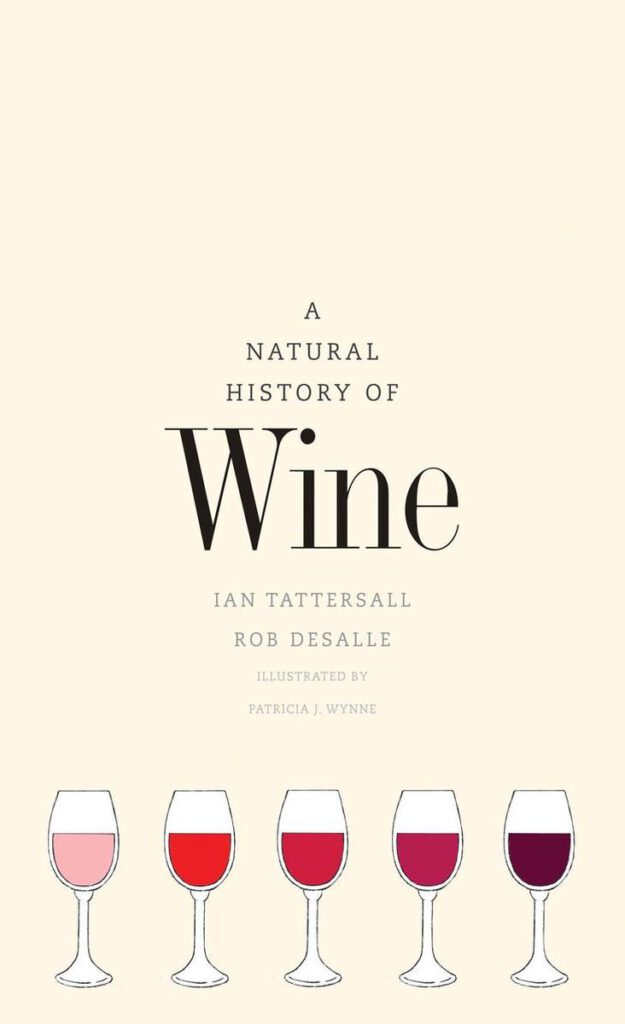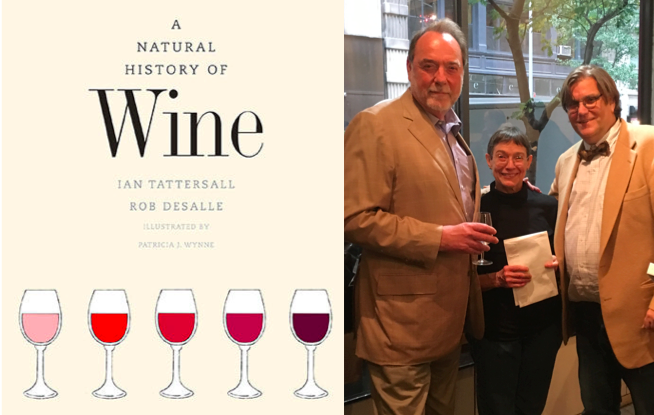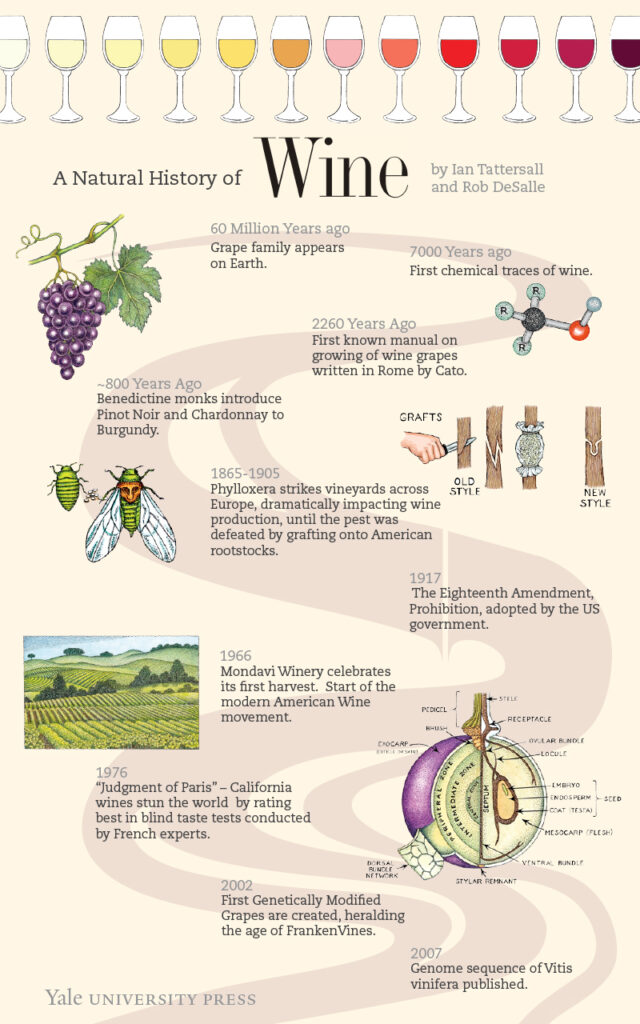
| Title | A Natural History of Wine |
| Author | Rob DeSalle, Ian Tattersall |
| Publisher | Yale University Press |
| Date | November 10, 2015 |
| ISBN | 9780300211023 (Hardcover) |
| Pages | 264 |
| Excerpt | google.com/books/edition/A_Natural_History_of_Wine/v_rDCgAAQBAJ |
| Audio | 8 hrs and 14 mins audible.com/pd/A-Natural-History-of-Wine-Audiobook/B0178FOB8Q |
| Synopsis | Was science ever more intoxicating? This sparkling contribution to the science of wine by palaeoanthropologist Ian Tattersall and entomologist Rob DeSalle draws on a staggering array of disciplines, from neurobiology to physics. Starting at the putative cradle of wine-making — an Armenian cave containing a 6,000-year-old proto-winery — the two trawl the research on frugivorous higher primates’ putative hankering for fermented fruit; the bodily journey of a “wine-derived ethanol molecule”; and the impact of climate change on cultivation [Books in Brief, Nature] |
| Shop | www.iantattersall.com/books/a-natural-history-of-wine |
| Review | As illustrated by the annotated bibliography, the authors did their research. The book provides a digest in twelve short chapters about archeology, biology, chemistry, ecology, technology, and other fields of study, and describe, for example, how exactly an ethanol molecule passes through the body to the brain, or the complex lifecycle of the phylloxera bug. |

About Tattersall, DeSalle & Wynne
Ian Tattersall (1945), Phd, is curator emeritus Anthropology of the American Museum of Natural History in New York City and has studied and written extensively about human fossils and lemurs.
- www.iantattersall.com
- www.amnh.org/research/staff-directory/ian-tattersall
- en.wikipedia.org/wiki/Ian_Tattersall
Rob DeSalle is a molecular biologist and curator at the AMNH.
Tattersall and DeSalle also teamed up to write
- A Natural History of Beer (YUP, 2019)
- Distilled – A Natural History of Spirits (YUP, 2022)
- Ian Tattersall – Beer or wine? The Origins Podcast, May 18, 2021 (YouTube)

Book Reviews
- www.terroirist.com/book-review-a-natural-history-of-wine-by-ian-tattersall-and-rob-desalle “recommend (…) to those with a semi-serious to serious interest in the science of wine. Spot-on review.
- wine-economics.org/jwe_reviews/a-natural-history-of-wine
… and for an fairly accurate AI-generated review “A Natural History of Wine” by Ian Tattersall explores the science behind wine, delving into its origins, evolution, and impact on human civilization.
- Interdisciplinary Approach: The book draws on various scientific fields, including paleontology, anthropology, genetics, microbiology, and neurobiology, to offer a comprehensive understanding of wine.
- Focus on Evolution: It examines the evolutionary history of the grapevine, highlighting the role of natural selection and human intervention in shaping its characteristics.
- Human-Wine Relationship: The book explores the long and complex relationship between humans and wine, tracing its origins back to ancient civilizations and its impact on social, cultural, and artistic developments.
- Accessible Writing Style: While scientifically rigorous, the book is written in an engaging and accessible style, making it enjoyable for both wine enthusiasts and those with a general interest in science.
Bibliography
- Vinous roots
- McGovern, Patrick E. Ancient Wine: The Search for the Origins of Viticulture. Princeton: Princeton University Press, 2003.
- Phillips, Rod. A Short History of Wine. London: Allen Lane 2000.
- Unwin, Tim. Wine and the Vine: An Historical Geography of Viticulture and the Wine Trade. London: Routledge, 1996.
2. Why we drink wine
3. Wine is stardust
4. Grapes and grapevines
5. Yeasty feasts
6. Interactions
7. The American disease
- Campbell, Christy. The Botanist and the Vintner: How Wine Was Saved for the World. New York: Algonquin Books of Chapel Hill, 2004.
- Gale, George D., Jr. Dying on the Vine: How Phylloxera Transformed Wine. Berkeley: University of California Press, 2011.
8. Reign of terroir
- Sommers, Brian J. The Geography of Wine: How Landscapes, Cultures, Terroir and the Weather Make a Good Drop. New York: Plume, 2008.
- White, Robert E. Soils for Fine Wines. Oxford: Oxford University Press, 2003.
- Wilson, James E. Terroir: The Role of Geology, Climate, and Culture in the Making of French Wines. Berkeley: University of California Press, 1998.
9. Wine and the senses
- Liger- Belair, Gérard. Uncorked: The Science of Champagne. Rev. ed. Princeton: Princeton University Press, 2013.
- Lukacs, Paul. Inventing Wine: A New History of One of the World’s Most Ancient Pleasures. New York: Norton, 2012
- McCoy, Elin. The Emperor of Wine: The Rise of Robert M. Parker, Jr., and the Reign of American Taste. New York: Ecco, 2005.
- McGovern, Patrick E. Uncorking the Past: The Quest for Wine, Beer, and Other Alcoholic Beverages. Berkeley: University of California Press, 2009.
- Peynaud, Émile. The Taste of Wine: The Art and Science of Wine Appreciation. San Francisco: Wine Appreciation Guild, 1997.
- Shepherd, Gordon M. Neurogastronomy: How the Brain Creates Flavor and Why It Matters. New York: Columbia University Press, 2012.
10. Voluntary madness
11. Brave new world
- Bird, David. Understanding Wine Technology: The Science of Wine Explained. 3rd ed. San Francisco: Wine Appreciation Guild, 2011.
- Goode, Jamie. The Science of Wine: From Vine to Glass. 2nd ed. Berkeley: University of California Press, 2014.
- Wallace, Benjamin. The Billionaire’s Vinegar: The Mystery of the World’s Most Expensive Bottle of Wine. New York: Crown, 2008.
12. Franken-vines and climate change
